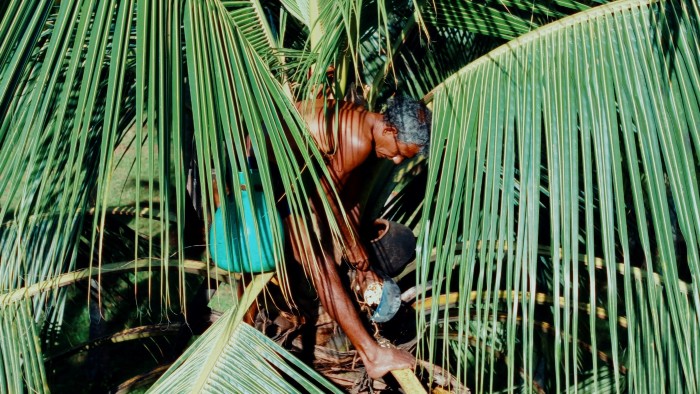
Ryan Chetiyawardana, through the Mr Lyan Studio, has partnered with Rockland Distilleries with a vision to grow the presence of Sri Lankan arrack behind bars.
Now, following the release of his documentary exploring the tradition and production of Ceylon Arrack, Class caught up with Chetiyawardana to chat about his vision for the category and how he’s championing Sri Lankan flavour.
So Ryan, Mr Lyan Studio is now working with Sri Lanka-based Rockland Distilleries, which produces Ceylon Arrack. Can you tell us about how the partnership came about and why you have a connection with the spirit?
I met Amal when I was a young bartender at Bramble, and he was a very kind supporter visiting me in the bars I worked at over the years. But after visiting Sri Lanka, my uncle told me about Rockland as the oldest family distillers. I learnt about arrack and halmilla ageing, but also brought back a bottle of Rockland's (domestic) gin, which ended up on the backbar at The Whistling Shop. This reconnected me with Amal when he came in to visit, and we've been friends since.
Over the years, I've been very keen to reconnect with Sri Lanka, and Amal was so helpful with this, and it was via these trips that I started to discover the magic and uniqueness of Ceylon Arrack. As a biologist, I was fascinated with the process, but as a professional, I was amazed by something that was singular in our industry, and something that represented a culture and connection to the land in such an incredible way.
Arrack is the spirit of Asia and can be made from a variety of ingredients, but Ceylon Arrack is different - having been out to the distillery to make a documentary about it, can you tell us about how it's made and what makes it unique?
The term arrack is wide and takes on many different forms in different cultures and parts of the world. But Ceylon Arrack has a very storied history, and crops across notable parts of drinks lore (including mentions by Marco Polo and Jerry Thomas), but its production is also really unique. It is a flower spirit, not something flavoured with flowers, but one made from the sap of the unopened flowers of the coconut palm.
The skill in managing and extracting this nectar is an ancient craft (not least for the skill of climbing and traversing the tree canopies) and really speaks to other ancient spirits that have these incredible knowledge and skills linked to the land that have been overlooked for so long. These toddy tappers manage the tying and cutting of the flowers, and then the collecting of sap early in the morning and late in the day. The sap, naturally rich in sugars and wild yeasts, ferments rapidly so this needs to be transported to the distillery within 24 hours. This alcoholic 'toddy' is filtered, mixed, then distilled, then matured in native halmilla wood. The result is a spirit that echoes its origins, lightly floral, with an incredible creaminess (it doesn't taste of coconut – the sap is collected before the coconut fruit starts to form), it has a light natural sweetness. It mixes like a white spirit but has the body of a lightly aged one.
Arrack is no new spirit - its history is as old as history books - so tell us about some of the drinking culture that surrounds it in Asia, and also how the spirit has made it into cocktail recipes over the years?
There are many old recipes that call for arrack (Jerry Thomas' Ruby Punch is probably one of the most notable), but it was key in punches and slings popular at the time, and with the colonial connections, versions made their way back to Holland and Portugal, (and up to Sweden) and it was mixed with tea and spices also from the island. But it was also locally drunk on the rocks or in simple highballs and traditionally drunk alongside food, and with its ability to play in both the white and aged spirit camps, it's become both a component of dishes and a drink to enjoy alongside.
You're very much a face of modern cocktails - so how do you see arrack fitting into the contemporary bartender's repertoire?
To me, as professionals, we should explore the entire breadth of the flavour world, and we have the opportunity to present these ideas to our guests to create new connections for them. Rockland celebrated its centenary recently, an incredible milestone in our industry, and with Ceylon Arrack, they represent an incredible story of culture, ingenuity and resilience, and those are always incredible human stories to celebrate and present to those interested in our world. But the spirit itself also represents something hugely unique; being distilled from flower sap, it represents a new flavour and textural component within our flavour toolbox to draw on. There is also a beauty – much like with mezcal, which also has ancient history and knowledge attached to it – that there isn't a set serve associated with it aside from sipping it alongside beer or food, so there's real scope to apply its versatility in some very unique modern serves.
You've also launched Three Families in collaboration with Rockland - tell us more about what 'seasonings' are and how we can use them?
These were amazing to create and were also born from our trips to Sri Lanka and not only exploring the bounty of the incredible produce, but also noticing the diversity of space, landscape and emotion in the country. We wanted to find a way for bartender and chef friends to have the ability to apply these incredible ingredients, but removing the issues of price or perishability often associated with tropical produce. We also didn't want to pigeon-hole them to 'bitters' as we knew the applications (especially when chatting with chef friends) were wider. So we took the expertise from Rockland and from Dilmah – exploring both sourcing ingredients and capturing flavour – and married them with the structural idea of bitters but in a profile that reflected different spaces within the country – from the tropical fruit and flowers of the markets, to the coastal warm breeze in the grasslands, to the vibrancy greenery of the rainforests – to be able to capture very wide sets of flavour that can be really useful for flavour application in a huge array of settings.
My favourite way to use them is to think on the emotion of the application – sometimes you want a green pop to lift, or you want the fullness of ripe tropical fruit, or the zesty earthiness to lift a drink. Of course, they can be used in their hero ingredient form – eg to add an authentic jasmine, or mangosteen, or lemongrass note to a drink, but I love using them to build a wider complexity in a variety of serves.
Chetiyawardana's documentary about the making of Ceylon Arrack can be found here.


